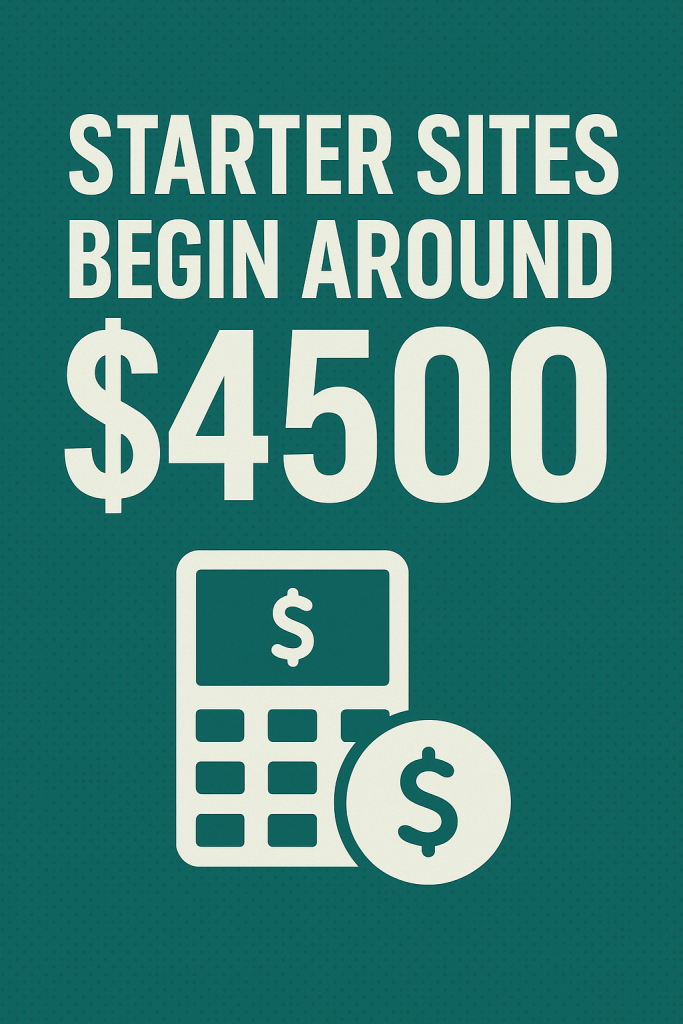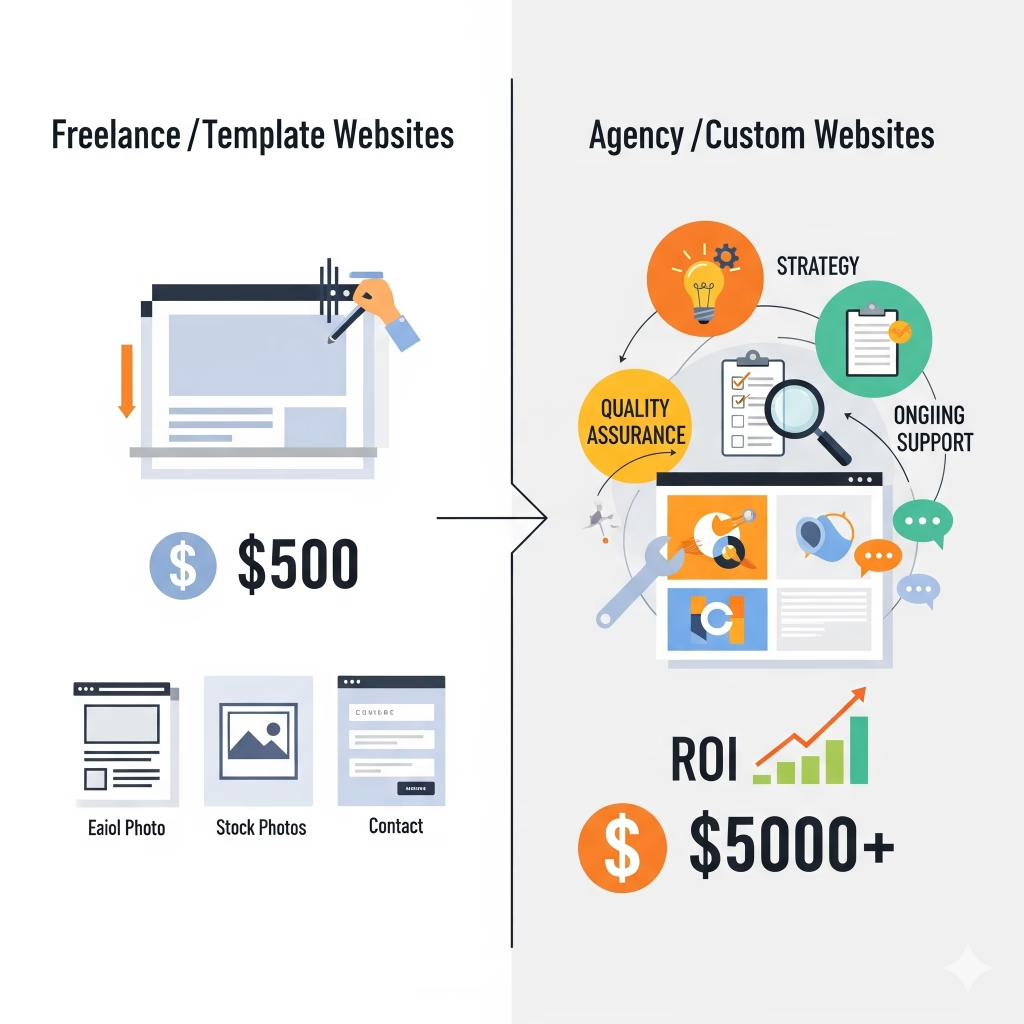
How to Save Money?
- Use a template (avoid 100% custom design).
- Prepare content (text/images) in advance.
- Choose a scalable platform (like WordPress) to avoid redesigns later.
Tip: Always ask for a detailed quote before hiring!
1. Basic Website (Template-Based)
- Price: $4,500 – $5,000
- Best for: Small businesses, portfolios, or simple blogs.
- Includes:
- Pre-made template (WordPress, Wix, Squarespace).
- Basic customization (colors, fonts, your content).
- Mobile-friendly design.
- 5-10 pages (Home, About, Services, Contact).
2. Custom Business Website
- Price: $5,000 – $20,000
- Best for: Growing businesses needing unique branding and functionality.
- Includes:
- Custom UI/UX design (original layouts, wireframes).
- Advanced features (contact forms, booking systems).
- SEO optimization.
- CMS (like WordPress) for easy updates.
3. E-Commerce Website
- Price: $10,000 – $50,000+
- Best for: Online stores with product listings, payments, and inventory.
- Includes:
- Platform setup (Shopify, WooCommerce).
- Product pages, cart, checkout, and security.
- Payment gateways (Stripe, PayPal).
- Mobile optimization.
4. Custom Web Applications
- Price: $25,000 – $100,000+
- Best for: SaaS, membership sites, or complex platforms.
- Includes:
- User accounts/dashboards.
- Database integration.
- API connections.
- Scalable architecture.
What Affects Cost?
- DIY Tools (Wix, Squarespace): $0 – $300/year (but limited flexibility).
- Freelancers: $30 – $150/hour (good for small projects).
- Agencies: $100 – $300/hour (best for custom work).
- Add-ons: SEO, copywriting, or ongoing maintenance (+$500–$5,000/year).
Beyond the upfront design and development, the discussion of website cost must also include hidden and ongoing expenses, which are frequently underestimated by clients new to the process. Hosting fees, domain renewals, SSL certificates, premium plugin licenses, content delivery networks, and regular security monitoring are all essential elements that keep a site reliable and professional. Neglecting these factors can create the illusion of a “cheap” website at first, but in practice, the lack of proper infrastructure quickly leads to downtime, slow loading speeds, and security vulnerabilities. These recurring expenses underscore the importance of working with providers who communicate transparently about long-term commitments rather than presenting overly simplified price tags. Comparisons published by independent resources like HostingAdvice highlight how service levels differ between providers and why the lowest option is rarely the most cost-effective in practice.
MORE LINKS:
What is web design?
Responsive website?
Do I need a website?
How long design takes?
Design vs development?
Website redesign
Mobile friendly?
Template vs custom
Good domain name?
HOW MUCH DOES WEBSITE DESIGN COST?
The cost of web design varies widely based on complexity, features, and who builds it. A basic site with a few informational pages and a clean design may cost significantly less than a custom-built platform with advanced features like e-commerce, booking systems, or integrations with external tools. Understanding what you need and what you don’t is key to getting an accurate and realistic quote.
If you hire a freelancer or use a template-based service, you might spend anywhere from a few hundred to a few thousand dollars, depending on their experience and the scope of the project. Agencies and professional studios like Wemaxa.com typically charge more, but also provide a more comprehensive service including strategy, design, development, quality assurance, mobile optimization, and ongoing support.
Custom websites, especially those built from scratch with tailored functionality, can cost significantly more due to the time, expertise, and coordination involved. These projects may include multiple design phases, coding custom components, and integrating business-specific features that go beyond the basics. For many businesses, this level of investment pays off through better performance, higher engagement, and longer-term scalability.
At Wemaxa.com, we provide transparent pricing based on the scope of your project. Whether you’re looking for a lean and efficient launch or a full-scale custom platform, we help you understand what’s included what’s optional, and what makes the most sense for your goals and budget.

When considering the overall cost of professional website design, it is important to understand that the price is rarely a flat figure and instead represents a spectrum shaped by numerous factors ranging from the complexity of the site to the experience of the design team handling the project. A simple informational website with only a handful of static pages will naturally sit at the lower end of the pricing scale because it requires less time for planning, content organization, and visual design. On the other hand, a fully interactive e-commerce platform with payment integrations, inventory management, customer portals, and advanced analytics demands far more development hours and creative resources, which inevitably increases the overall cost. Many small business owners are often surprised at how wide the gap can be between template-based, entry-level solutions and highly customized professional builds, and while both options can technically deliver a working website, the long-term return on investment differs drastically. The right decision depends not only on your current budget but also on how you anticipate your digital presence evolving over the coming years. To explore current industry averages, you can review detailed breakdowns provided by platforms such as Clutch, which frequently publishes market research on design and development costs.
Another major element influencing cost is the design approach. Companies that rely heavily on ready-made templates or drag-and-drop builders can reduce expenses significantly because they do not need to invest time into creating unique design systems, wireframes, and component libraries. However, while such shortcuts may deliver something functional in the short term, they often result in websites that feel generic, lack strong brand identity, and provide limited flexibility for future scaling. Conversely, agencies or studios that craft a custom design process with careful consideration of typography, imagery, color theory, and user interface flows are providing not just a service but an investment into brand storytelling. This investment adds measurable value, particularly when the website serves as a critical sales channel or trust-building tool for clients. For a clear perspective on why custom design has enduring benefits, industry experts at Smashing Magazine regularly publish insights showing how thoughtful user experience design translates into higher engagement and conversion rates, which ultimately offsets the higher initial costs.
The integration of additional functionality is also a significant cost driver, and this includes features that many businesses assume are standard until they realize they require specific development. Examples include booking systems, multilingual support, customer login areas, interactive product configurators, or advanced SEO tools. Each of these requires specialized coding, plugin configurations, or third-party API integrations that extend project timelines and increase the price. The reality is that when clients request these advanced functionalities, the website is no longer just a static presence on the web but begins to operate as a digital platform with moving parts that need long-term maintenance and monitoring. The costs associated with developing such systems are not merely development fees but also the overhead of future updates and security management. For a technical deep dive into the effort required to implement such features, resources like MDN Web Docs provide extensive documentation illustrating the intricacies of modern web technologies.

Finally, one cannot ignore the human aspect of cost. Choosing an established design studio with a reputation for delivering polished results generally comes at a higher price than hiring freelancers or offshore teams, but this premium often reflects reliability, structured project management, and the ability to provide long-term support. A reliable partner ensures the continuity of your online presence, especially when future updates, redesigns, or marketing campaigns demand consistent branding. Cheap solutions may seem appealing initially, but they frequently collapse under the pressure of growth, forcing business owners to reinvest in a proper rebuild. When calculating website design costs, it is therefore critical to look beyond the immediate price and evaluate the broader value proposition: scalability, brand strength, performance, and trustworthiness. The cumulative effect of these factors is what determines whether the investment results in an asset that strengthens your business or a liability that drains resources. For those seeking comparative cost estimates from across the globe, organizations such as Upwork and Freelancer provide live market data illustrating the wide spread of rates and quality levels, which is a useful reference point when weighing your options.
Need help estimating costs for your specific project?
Share your goals, and we’ll refine the numbers!


